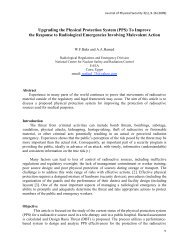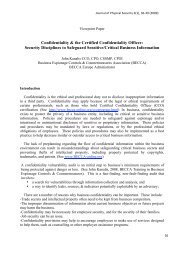PDF - The Journal of Physical Security - Argonne National Laboratory
PDF - The Journal of Physical Security - Argonne National Laboratory
PDF - The Journal of Physical Security - Argonne National Laboratory
You also want an ePaper? Increase the reach of your titles
YUMPU automatically turns print PDFs into web optimized ePapers that Google loves.
<strong>Journal</strong> <strong>of</strong> <strong>Physical</strong> <strong>Security</strong> 4(2), 10-29 (2010)any object experiencing the increased pressure. This portion <strong>of</strong> the blast wave is then followed by asmaller drop in pressure below the ambient pressure and a more gradual return to atmospheric pressure.This portion can exert suction on an object, and can also deliver debris to the object that has been suckedinto the blast wave.In a crude analysis, the effect <strong>of</strong> a blast wave on a structure is related to the magnitude <strong>of</strong> theoverpressure. Thus, in FEMA and DOD documents, tables similar to Table 1 are <strong>of</strong>ten displayed. Table1, taken from the DOD document TB 700-2 (cited in Jeremic and Bajic, 2006), lists the types <strong>of</strong> damageto be expected from various blast overpressures.Table 1. Expected shock wave effects on objects (from DOD’s TB 700-2, cited in Jeremic and Bajic, 2006). - psiunits added______________________________________________________________________________No. Overpressure Expected damagekPapsi______________________________________________________________________________1 1.0-1.5 0.15-0.22 Window glass cracks2 3.5-7.6 0.51-1.1 Minor damage in some buildings3. 7.6-12.4 1.1-1.8 Metal panels deformed4. 12.4-20 1.8-2.9 Concrete walls damage5. Over 35 Over 5.1 Wooden construction buildings demolition6. 27.5-48 4.0 -7.0 Major damage on steel construction objects7. 40-60 5.8-8.7 Heavy damage on reinforced concrete buildings8. 70-80 10-11.6 Probable demolition <strong>of</strong> most buildings______________________________________________________________________________However, the duration <strong>of</strong> the pressure pulse in the blast also plays a role in determining damage, i.e. thedamage is related to the impulse as well as to the overpressure. An example <strong>of</strong> this is given in Figure 5,based on a figure from DOD’s TM15-1300 (cited in Ngo, Mendix, Gupta, Ramsay, 2007). Figure 5shows a design chart for a tempered glass panel. It shows clearly that the survival <strong>of</strong> a panel depends notjust on the peak pressure but also on the blast impulse to which it will be subjected.<strong>The</strong> reason why both overpressure and impulse are important in determining structure damage becomesevident in a simple model that is sometimes used to describe blast wave/structure interaction: In thismodel - the so-called single degree if freedom (SDOF) model - the structure (or an element <strong>of</strong> thestructure) is replaced by an equivalent system <strong>of</strong> one concentrated mass and one weightless spring thatrepresents the resistance <strong>of</strong> the structure to deformation.17





